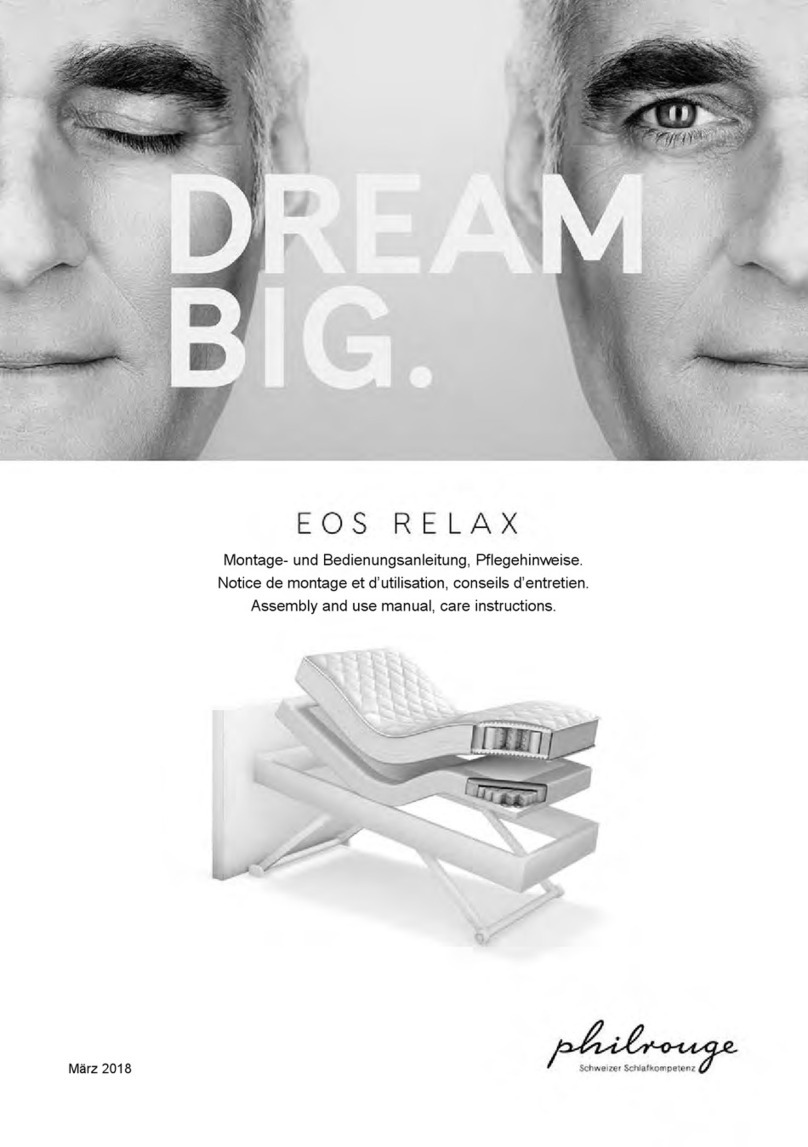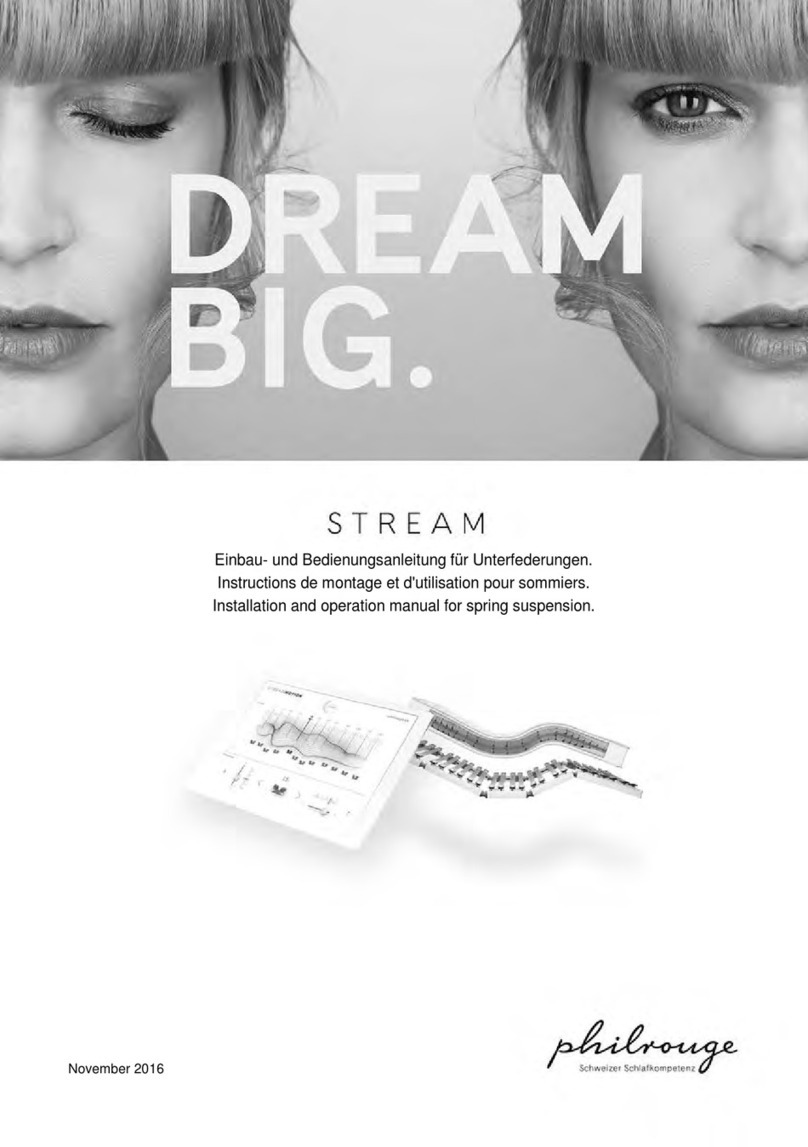
14 15
1.1 Formation de bruits/grincements
Nos systèmes de lit sont évidemment construits et
dimensionnés de sorte que la formation de bruits
soit évitée, ou bien minimisée jusqu’à ne plus être
ressentie comme gênante.
Cela suppose toutefois également que le lit ait été
assemblé et monté selon les étapes de la notice de
montage.
Il convient en outre de veiller à une mise en place
sans torsion ni tension du lit. Le montage d’un seul
côté sur les bords d’un tapis ou des sols irréguliers
entraîne la déformation du coffre à literie et de
l’ensemble du support et par la suite, la torsion de
composants mobiles tels que la tige des moteurs et
les paliers. Calage au moyen des pieds réglables
ou bien en positionnant des matériaux appropriés
sous les pieds.
1.2 Points de pression au sol
Sur les sols souples (bois, plastique, liège, moquette,
etc.), les pieds de meubles peuvent laisser des mar-
ques et des égratignures. Il est au moins possible de
remédier à cela, en cas de sols lisses en apposant
des patins de protection en feutre sur l’envers et en
cas de sols rugueux en apposant des rondelles de
feutre.
1.3 Climat intérieur
Protégez votre lit contre une exposition directe au
soleil ou bien une lumière vive étant donné que les
tissus et bois n’ont pas une résistance absolue à la
lumière. Un fort éclairage au néon ou halogène peut
également entraîner une altération de la couleur ou
du matériau et une décoloration.
Le taux d’humidité idéal dans la pièce devrait se
situer entre 45% et 55%. En cas de valeurs inféri-
eures, les matériaux naturels deviennent cassants et
le synthétique a tendance à se charger en électricité
statique et à plus s’encrasser. Une hygrométrie plus
élevée favorise le développement éventuel de moisis-
sures. Veuillez respecter les instructions suivantes:
Sécurité et utilisation
1. Instructions relatives à l’utilisation et la mise en place du lit
– Aérez régulièrement votre chambre à coucher
(brève aération).
– Afin de garantir une circulation d’air suffisante
au-dessus et en-dessous du matelas, secouer
régulièrement couvertures et coussins et les retour-
ner quelques heures. Etendre à nouveau le couvre-
lit uniquement après aération du lit.
– Particulièrement en cas d’utilisation supplémentaire
d’un sur-matelas (topper), celui-ci doit être retourné
de temps en temps.
– Veillez à ce qu’il y ait suffisamment de distance
jusqu’aux radiateurs et assurez une aération
arrière suffisante entre le mur et la partie tête.
1.4 Traces d’usure
Même les surfaces, tissus et housses de haute qualité
employés ne résistent pas à toutes les contraintes
d’une utilisation quotidienne. Des détériorations ou
traces peuvent par exemple résulter de:
– objets tranchants, pointus, tels que des bracelets,
bijoux, chaînes, barrettes, etc.
– griffes d’animaux domestiques
– substances chimiques, telles que des teintures
capillaires, du gel coiffant, de la laque, du maquil-
lage, des crèmes et lotions, des cosmétiques
– cheveux gras et transpiration, effluves de person-
nes sous traitement médical régulier
– liquides alcoolisés et jus de fruits
Ne pas couper les fils tirés mais les tirer vers l’inté-
rieur. Si un fil est arraché, cela crée un trou dans la
housse!
Des traces d’usure de ce type sont exclus de la
garantie et ne peuvent pas faire l’objet de réclama-
tions.
1.5 Altérations de la couleur dues à des vêtements
ou housses de couette, boulochage
Aucune responsabilité ne pourra être assumée pour
la résistance des couleurs d’autres tissus de vête-
ments et de housses de couette pouvant déteindre
sur le sommier tapissier. Il ne s’agit ici nullement d’un
défaut du tissu de la housse mais d’une défectuosité
des tissus de vêtements ou du linge de lit employé.
FR
Le terme boulochage désigne la formation de
nodules sur des tissus, résultant la plupart du temps
du frottement de différents tissus (faux boulochage),
p. ex. de linge de lit. La tendance à boulocher peut
être favorisée par un climat humide et/ou de l’élec-
tricité statique.
Il s’agit d’une caractéristique typique du matériau et
non d’une défectuosité. Avec un rasoir anti bouloche
spécial, les boulochages peuvent de nouveau être
éliminés sans problème.
1.6 Variations de couleurs
Outre les variations de couleurs dus à différents sens
de tissus résultant de la production ou du traitement,
les matériaux de la housse présentent des variations
de couleurs d’usage. C’est pourquoi des variations
de couleurs sont également possibles au niveau de
l’échantillon en exposition ou de pièces livrées anté-
rieurement.
1.7 Caractéristiques de traitement
Selon l’aspect du matelas, les produits rembourrés
sont traités de façon tonique ou moelleuse. Un traite-
ment moelleux signifie un confort accru grâce à
l’accueil en douceur dans le matelas. L’aspect voulu
se forme à l’usage par la formation individuelle de
plis et ondulations en raison la faible tension de la
housse, p. ex. en cas de matelas recouvert de tissus
d’ameublement. Après utilisation, les surfaces peu-
vent être aplanies vers l’extérieur ou tapotées.
Dans la zone de matelas, de nombreux matériaux
souples sont travaillés. Le rembourrage et la couture
sont réalisés à la main – c’est pourquoi des diffé-
rences de dimensions par rapport aux tailles indi-
quées sont possibles, de +/- 1% en longueur et en
largeur. Des différences de taille peuvent également
résulter du stockage ou du transport. En règle géné-
rale, le produit retrouve sa dimension nominale lors
de l’utilisation.
1.8 Odeur de neuf et comportement en position
allongée
Les nouveaux produits ont toujours une odeur pro-
pre, spécifique au matériau. Cela est absolument
sans risques et disparaît au fil du temps. Un remède
consiste en une aération plus fréquente.
Chaque sommier tapissier et chaque matelas
s’adapte au fil du temps au dormeur. Les fines cou-
ches de rembourrage de haute qualité sont com-
pactées. Ainsi se forme un creux à la surface du
matelas. En tournant le matelas régulièrement, le
revêtement du rembourrage se détend de nouveau.
Les matelas s’assouplissent légèrement à l’usage,
en moyenne d’env. 10–15 %. Ce sont des propriétés
typiques du produit et des variations de fermeté
qui ne sont pas couvertes par la garantie.
1.9 Entretien et élimination des tâches
Entretien régulier
Passez délicatement l’aspirateur avec une brosse à
épousseter et brossez avec une brosse souple pous-
sières, miettes, salissures superficielles.
Ne jamais aspirer le sur-matelas et les matelas dans
les tissus de matelas! Ne jamais utiliser de nettoyeur
à vapeur!
En cas de matelas avec housse de matelas et de
sur-matelas (topper), respecter les instructions sur
les étiquettes d’entretien cousues.
Cuir synthétique
Frotter avec précaution la housse avec une peau
de chamois propre, légèrement humide. L’humidité
préserve l’élasticité du matériau. Traiter les taches
tenaces avec de l’eau légèrement savonneuse.
Taches
Le temps compte, plus vous éliminerez une tache
rapidement, meilleures seront les chances de réus-
site. Pour cela, selon les cas, travailler de couture
en couture mais toujours du bord vers le milieu afin
que la tache ne s’agrandisse pas. Utilisez un chiffon
blanc, souple, propre, et travaillez en exerçant une
légère pression afin de ne pas abîmer la structure
superficielle.
FR

































